Kawasaki Heavy Industries Bundle
Decoding Kawasaki Heavy Industries: How Does It Thrive?
Kawasaki Heavy Industries (KHI), a titan of Japanese manufacturing, is a global force spanning diverse sectors. Witnessing a surge in revenue and profitability, with projections soaring for the fiscal year ending March 2025, KHI's financial prowess demands attention. Its strategic pivot towards sustainability and innovation positions it at the forefront of emerging markets.
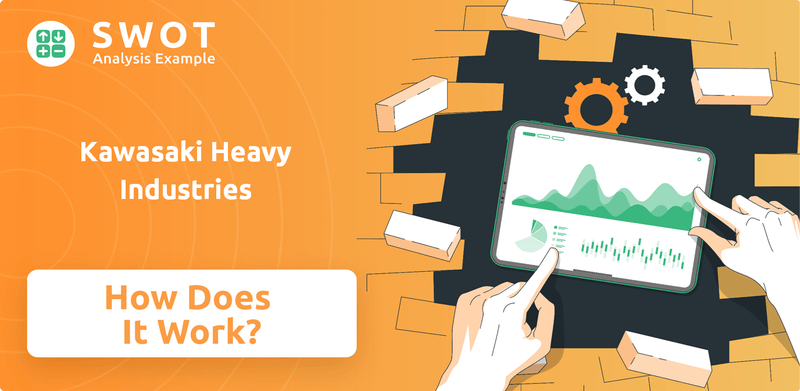
This analysis will dissect the inner workings of the Kawasaki company, exploring its core value propositions and diverse revenue streams. We'll examine key strategic moves, competitive positioning, and future outlook, providing a comprehensive understanding of its ability to generate sustained profit. For a deeper dive into its strategic strengths and weaknesses, consider the Kawasaki Heavy Industries SWOT Analysis.
What Are the Key Operations Driving Kawasaki Heavy Industries’s Success?
Kawasaki Heavy Industries (KHI) operates as a diversified industrial conglomerate, delivering value through a wide range of products and services. Its core operations are structured across several key segments, including motorcycles & engines, rolling stock, aerospace, energy systems & plant engineering, precision machinery, and ship & offshore structure. This multifaceted approach allows KHI to serve diverse customer segments globally, leveraging its integrated engineering expertise.
The company's value proposition centers on providing advanced, reliable, and sustainable solutions. KHI emphasizes innovation and sustainability, targeting net-zero carbon emissions by 2050. This commitment, along with its diverse portfolio and global presence, differentiates the company in competitive markets. A look at the Competitors Landscape of Kawasaki Heavy Industries shows the breadth of the industry.
KHI's operations are unique due to its broad, integrated engineering expertise across heavy industries, enabling synergistic development and cross-segment innovation. This comprehensive capability translates into customer benefits such as advanced, reliable, and increasingly sustainable solutions, differentiating KHI in competitive markets.
KHI manufactures motorcycles, ATVs, and ROVs. The company is investing over JPY30 billion by 2025 to double its ROV production capacity. Electric and hybrid motorcycles are also part of the product line, aligning with carbon neutrality goals.
This segment focuses on manufacturing Shinkansen trains, conventional trains, and locomotives. KHI provides comprehensive railcar supply and maintenance solutions, particularly in Asia and North America. This division leverages KHI's technical and manufacturing capabilities.
KHI manufactures finished aircraft and supplies engines and components. The company collaborates with partners like Airbus. Operations emphasize high quality and productivity through leading-edge production technology.
This segment provides solutions leveraging gas turbines and waste heat recovery. KHI is involved in hydrogen-related technologies, including hydrogen gas turbines and centrifugal hydrogen compressors. The first centrifugal hydrogen compressor for liquefaction plants is scheduled for completion by November 2025.
Precision machinery includes industrial robots, where KHI is the world's third-largest manufacturer. The company develops versatile and collaborative robots. The ship & offshore structure segment involves manufacturing ships, including liquefied hydrogen carriers.
- KHI is expanding its robot offerings to include humanoid robots and surgical robot systems.
- Partnerships, such as the one with Dexterity, enhance warehouse automation capabilities.
- The focus on liquefied hydrogen carriers supports KHI's future hydrogen business strategy.
- KHI's commitment to innovation and sustainability differentiates it in the market.
Kawasaki Heavy Industries SWOT Analysis
- Complete SWOT Breakdown
- Fully Customizable
- Editable in Excel & Word
- Professional Formatting
- Investor-Ready Format
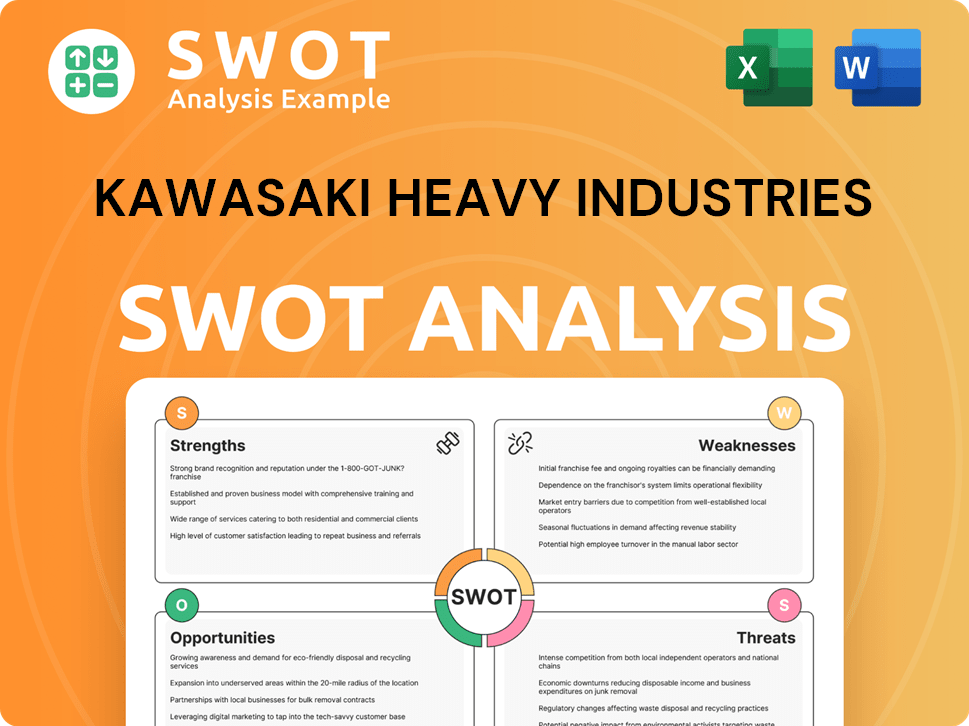
How Does Kawasaki Heavy Industries Make Money?
Kawasaki Heavy Industries (KHI), a prominent Japanese manufacturing and industrial conglomerate, generates revenue through a diverse range of business segments. This multifaceted approach reflects its global presence and involvement in various sectors. KHI's financial performance is driven by a mix of product sales, service contracts, and technology licensing.
For the fiscal year ending March 31, 2025, Kawasaki Heavy Industries reported an annual revenue of JPY2.13 trillion. This represents a significant 15.14% growth compared to the previous fiscal year. The company anticipates a revenue forecast of JPY2,160,000 million for the fiscal year ending March 31, 2025.
The company's monetization strategies include direct product sales, long-term service and maintenance contracts, and licensing of its advanced technologies. Additionally, Kawasaki is exploring innovative monetization strategies, particularly in the hydrogen sector, aiming to establish a large-scale Direct Air Capture (DAC) demonstration plant by 2025.
The Power Sports & Engine segment was the primary revenue driver for fiscal year 2025, contributing JPY610.7 billion, accounting for approximately 29% of total revenue. This segment includes motorcycles, recreational off-highway vehicles (ROVs), and general-purpose engines. Kawasaki company is expanding sales in key markets like North America.
This segment focuses on the sales of motorcycles, ATVs, and ROVs. KHI is actively expanding production capacity and introducing new models, including electric and hybrid versions. This segment is a significant revenue generator for the Kawasaki products.
The Rolling Stock segment involves the sales of railway vehicles, including Shinkansen trains, subway trains, and locomotives. This segment has returned to profitability in recent periods. This is an important part of the Kawasaki company.
This segment is responsible for the manufacturing and sales of aircraft, components for commercial aircraft, and defense equipment. In 2024, this division accounted for 20.2% of sales. This sector highlights Kawasaki Heavy Industries' aerospace technology.
This segment generates revenue from gas turbines, power generation plants, and environmental equipment. It is a key area for future growth, particularly with investments in hydrogen-related technologies. This segment is a key part of Kawasaki Heavy Industries' energy solutions.
This segment involves the sales of industrial robots and hydraulic components. The robotics sector accounted for 14.6% of sales in 2023. KHI is expanding its offerings in this area through partnerships and new product development.
This segment focuses on shipbuilding, including liquefied natural gas (LNG) carriers and, increasingly, liquefied hydrogen carriers. This segment shows Kawasaki Heavy Industries' shipbuilding process.
Kawasaki Heavy Industries is actively pursuing innovative monetization strategies, especially in the hydrogen sector. The company aims to establish a large-scale Direct Air Capture (DAC) demonstration plant by 2025, targeting a business scale of approximately 50 billion yen by 2030. Further expansion is planned through licensing by 2050. KHI is also leveraging sustainable finance measures, such as issuing transition bonds for hydrogen projects, to support its decarbonization solutions. For more details, you can refer to this article about Kawasaki Heavy Industries business model explained.
- Direct product sales form a core part of KHI's revenue model.
- Long-term service and maintenance contracts provide recurring revenue streams.
- Technology licensing allows Kawasaki to monetize its intellectual property.
- Expansion into hydrogen-related technologies represents a significant growth opportunity.
Kawasaki Heavy Industries PESTLE Analysis
- Covers All 6 PESTLE Categories
- No Research Needed – Save Hours of Work
- Built by Experts, Trusted by Consultants
- Instant Download, Ready to Use
- 100% Editable, Fully Customizable
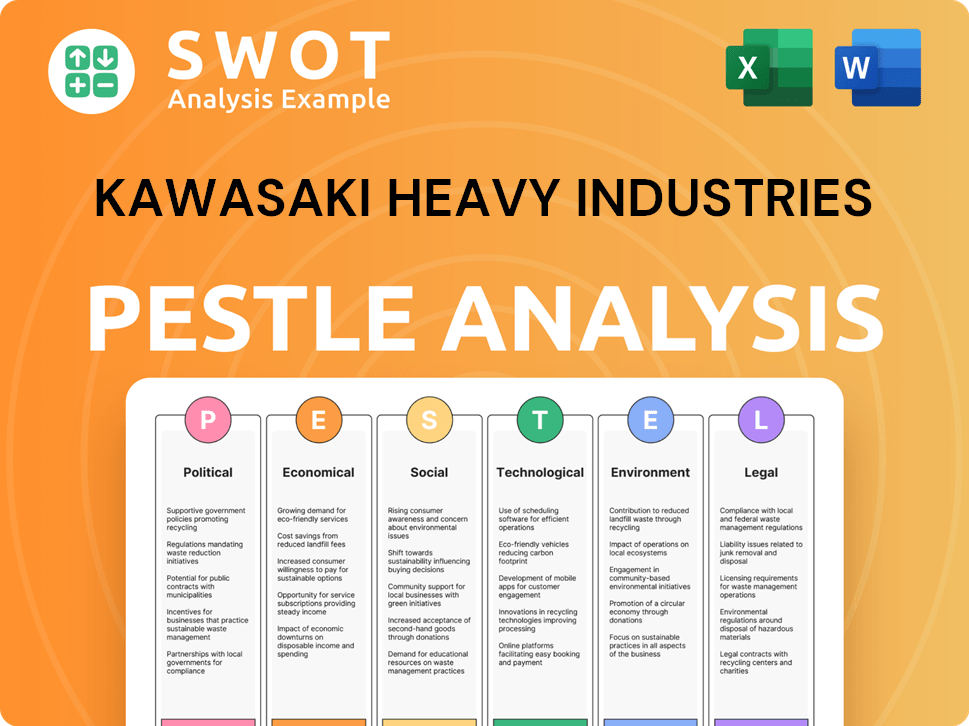
Which Strategic Decisions Have Shaped Kawasaki Heavy Industries’s Business Model?
Kawasaki Heavy Industries (KHI) has navigated significant milestones and strategic shifts, profoundly impacting its operations and financial outcomes. A major strategic pivot began in 2023, emphasizing sustainability and aiming to dominate emerging markets in hydrogen energy, carbon-neutral logistics, and smart manufacturing. This forward-thinking approach has positioned the company to capitalize on evolving global demands.
In the fiscal year ending March 31, 2025, the Kawasaki company achieved record business profit of JPY143.1 billion, surpassing the forecast of JPY130 billion. Revenue also exceeded JPY2 trillion for the first time, reaching JPY2,129.3 billion. This financial performance highlights a strong post-COVID recovery, with EBITDA growing by an average of 70% per year between 2021 and 2023, demonstrating robust operational efficiency and market adaptation.
The company's history and evolution can be traced back through a brief history of Kawasaki Heavy Industries, showcasing its adaptability and innovation across various sectors.
Kawasaki has consistently achieved significant milestones. The company's expansion in the Power Sports & Engine segment, particularly in North America, is a key focus. Kawasaki is investing over JPY30 billion by 2025 to double its Recreational Off-highway Vehicle (ROV) production capacity.
Strategic moves include significant investments in the Power Sports & Engine segment, particularly in North America. The company launched its first electric motorcycles and the world's first strong hybrid motorcycle in 2024, and publicly demonstrated a hydrogen-engine equipped motorcycle. The company is also focusing on hydrogen energy and decarbonization.
Kawasaki's competitive advantages stem from its diversified expertise, technological leadership, and strong brand. The company's ability to innovate across various heavy industries, from advanced manufacturing technologies with an 18% efficiency increase, to its leadership in hydrogen and robotics, provides a significant edge.
In the aerospace sector, Kawasaki continues to be a key supplier to the Japanese army and international customers like Boeing, holding a 25.5% share of contracts awarded by the Ministry of Defense by 2022. In April 2025, Kawasaki received the 'Embraer Best Suppliers of the Year 2024' award for its high-quality wing components.
A major strategic focus is on hydrogen. Kawasaki is aiming to become a pioneer in decarbonization using hydrogen, with plans to launch the world's first liquefied hydrogen carrier and develop hydrogen turbines by 2030. The company began construction of a demonstration facility for the world's first centrifugal hydrogen compressor for liquefaction plants, scheduled for completion by November 2025.
- The company is developing hydrogen turbines by 2030.
- Construction of a demonstration facility for a hydrogen compressor is underway, with completion expected by November 2025.
- In May 2025, Kawasaki unveiled a naval version concept of its high-energy laser system, designed to counter unmanned aircraft.
- Kawasaki is investing over JPY30 billion by 2025 to double its Recreational Off-highway Vehicle (ROV) production capacity.
Kawasaki Heavy Industries Business Model Canvas
- Complete 9-Block Business Model Canvas
- Effortlessly Communicate Your Business Strategy
- Investor-Ready BMC Format
- 100% Editable and Customizable
- Clear and Structured Layout
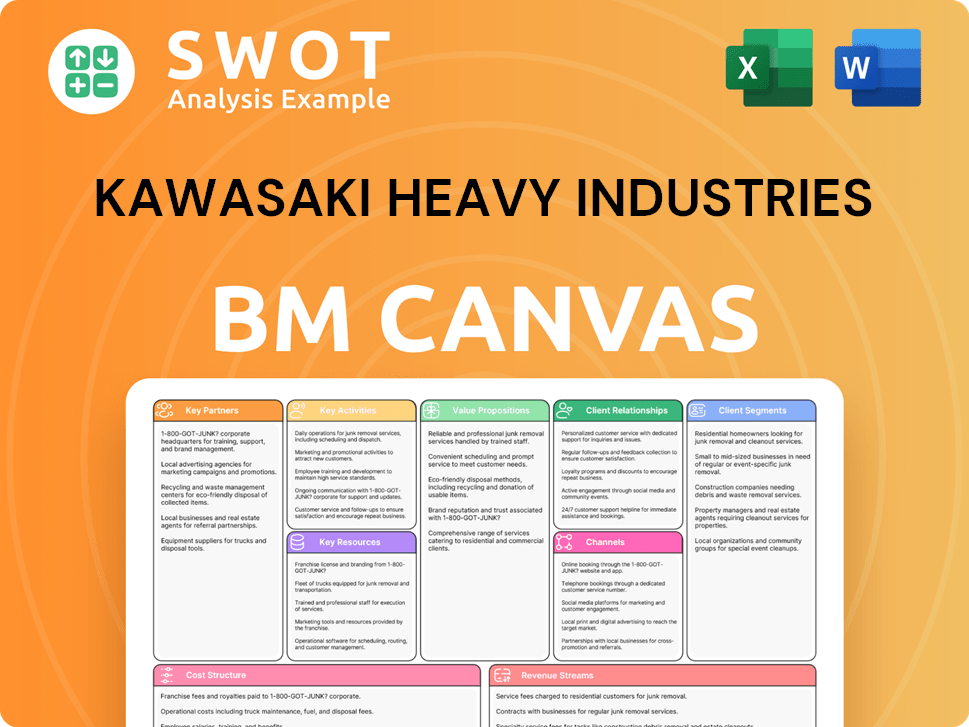
How Is Kawasaki Heavy Industries Positioning Itself for Continued Success?
Kawasaki Heavy Industries (KHI) holds a strong position in the heavy industries sector, with a global presence and diverse operations. The company is a key player in aerospace, marine, energy, and precision machinery, with a significant portion of its sales generated outside of Japan. This article will explore the industry position, associated risks, and future outlook for the Kawasaki company.
The company's stock has shown impressive performance, with a substantial increase in share price since the beginning of 2024. However, the future outlook also includes risks related to economic conditions, trade policies, and compliance issues. Kawasaki is actively pursuing strategic initiatives and focusing on innovation to ensure sustained growth.
Kawasaki is a leading Japanese manufacturing conglomerate with a global footprint. The company is recognized as the world's third-largest manufacturer of industrial robots. KHI's operations span various sectors, including aerospace, marine, energy, and precision machinery, demonstrating a diversified business model.
The company faces risks such as sensitivity to the economic climate, which can impact margins. U.S. tariffs pose a challenge, particularly in the Power Sports & Engine segment. Compliance issues, as highlighted in fiscal year 2024, also present a potential concern. Owners & Shareholders of Kawasaki Heavy Industries should be aware of these factors.
The future outlook for Kawasaki Heavy Industries is positive, with revenue forecast to grow by 6.6% annually over the next three years. Earnings per share (EPS) are expected to increase by 10.7% per annum. The company plans to exceed its record business profit of JPY143.1 billion in fiscal year 2024, forecasting a new record of JPY145 billion for fiscal year 2025.
Kawasaki is investing heavily in hydrogen technologies, aiming to be a leader in the hydrogen sector by 2030. This includes developing liquefied hydrogen carriers and hydrogen gas turbines. The company is also focusing on Direct Air Capture (DAC) technologies, with plans for a large-scale DAC demonstration plant by 2025.
Kawasaki Heavy Industries is a major player in the global market, with diverse operations and a strong focus on innovation and sustainability. The company is actively pursuing strategic initiatives to strengthen its competitive advantages. KHI's commitment to hydrogen technologies and DAC demonstrates its vision for the future.
- Leading Position: Kawasaki is a key player in aerospace, marine, energy, and robotics.
- Financial Performance: The company's stock has performed well, with positive growth forecasts.
- Strategic Focus: KHI is investing in hydrogen technologies and sustainability initiatives.
- Growth Targets: The company aims to achieve net-zero carbon emissions by 2050.
Kawasaki Heavy Industries Porter's Five Forces Analysis
- Covers All 5 Competitive Forces in Detail
- Structured for Consultants, Students, and Founders
- 100% Editable in Microsoft Word & Excel
- Instant Digital Download – Use Immediately
- Compatible with Mac & PC – Fully Unlocked
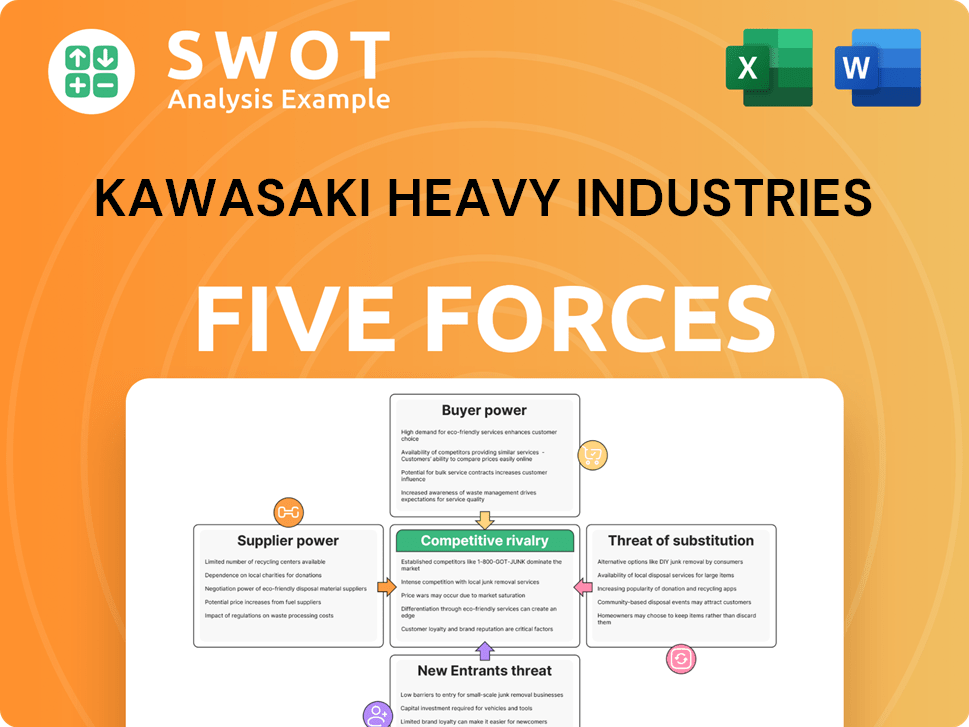
Related Blogs
- What are Mission Vision & Core Values of Kawasaki Heavy Industries Company?
- What is Competitive Landscape of Kawasaki Heavy Industries Company?
- What is Growth Strategy and Future Prospects of Kawasaki Heavy Industries Company?
- What is Sales and Marketing Strategy of Kawasaki Heavy Industries Company?
- What is Brief History of Kawasaki Heavy Industries Company?
- Who Owns Kawasaki Heavy Industries Company?
- What is Customer Demographics and Target Market of Kawasaki Heavy Industries Company?
Disclaimer
All information, articles, and product details provided on this website are for general informational and educational purposes only. We do not claim any ownership over, nor do we intend to infringe upon, any trademarks, copyrights, logos, brand names, or other intellectual property mentioned or depicted on this site. Such intellectual property remains the property of its respective owners, and any references here are made solely for identification or informational purposes, without implying any affiliation, endorsement, or partnership.
We make no representations or warranties, express or implied, regarding the accuracy, completeness, or suitability of any content or products presented. Nothing on this website should be construed as legal, tax, investment, financial, medical, or other professional advice. In addition, no part of this site—including articles or product references—constitutes a solicitation, recommendation, endorsement, advertisement, or offer to buy or sell any securities, franchises, or other financial instruments, particularly in jurisdictions where such activity would be unlawful.
All content is of a general nature and may not address the specific circumstances of any individual or entity. It is not a substitute for professional advice or services. Any actions you take based on the information provided here are strictly at your own risk. You accept full responsibility for any decisions or outcomes arising from your use of this website and agree to release us from any liability in connection with your use of, or reliance upon, the content or products found herein.